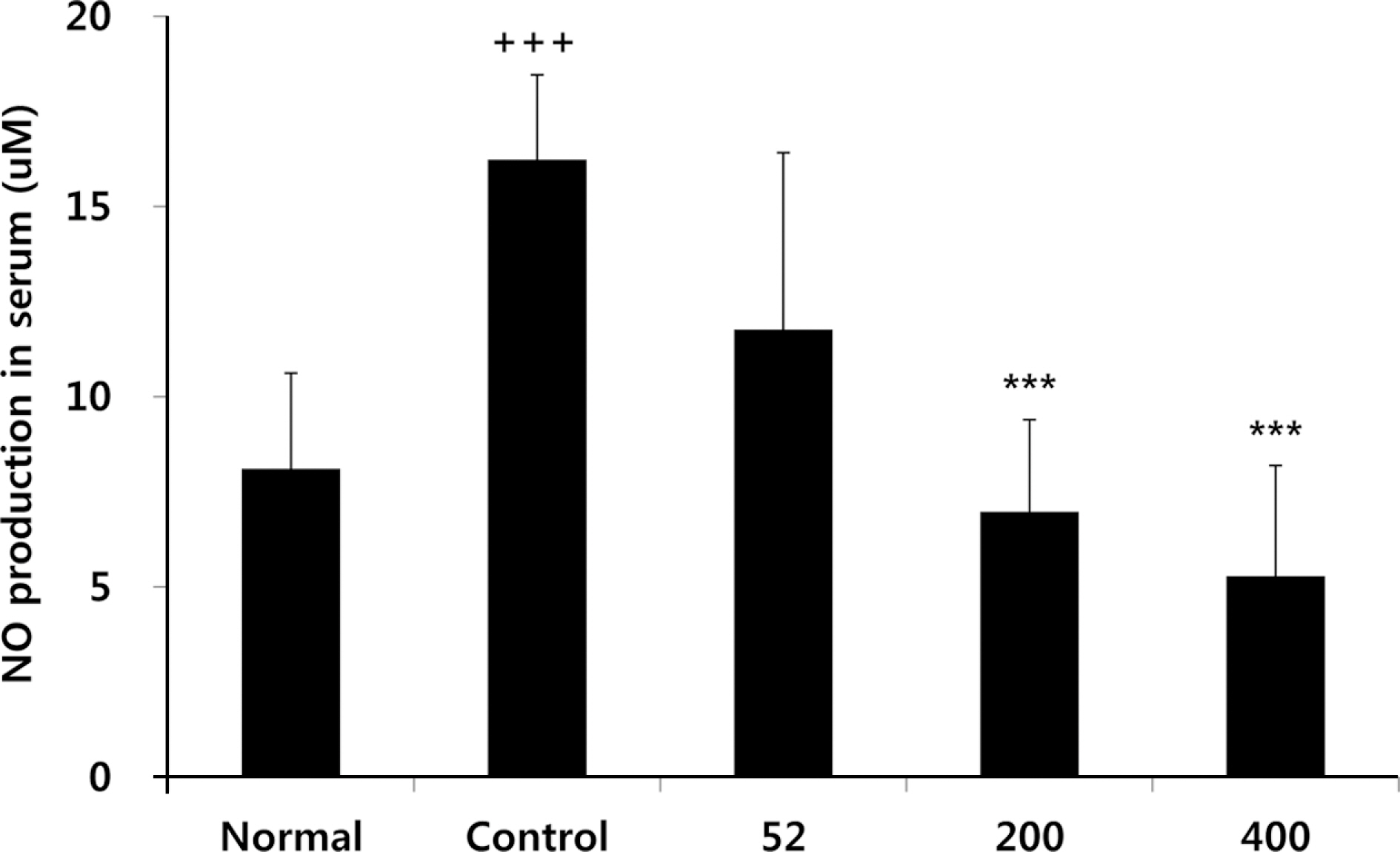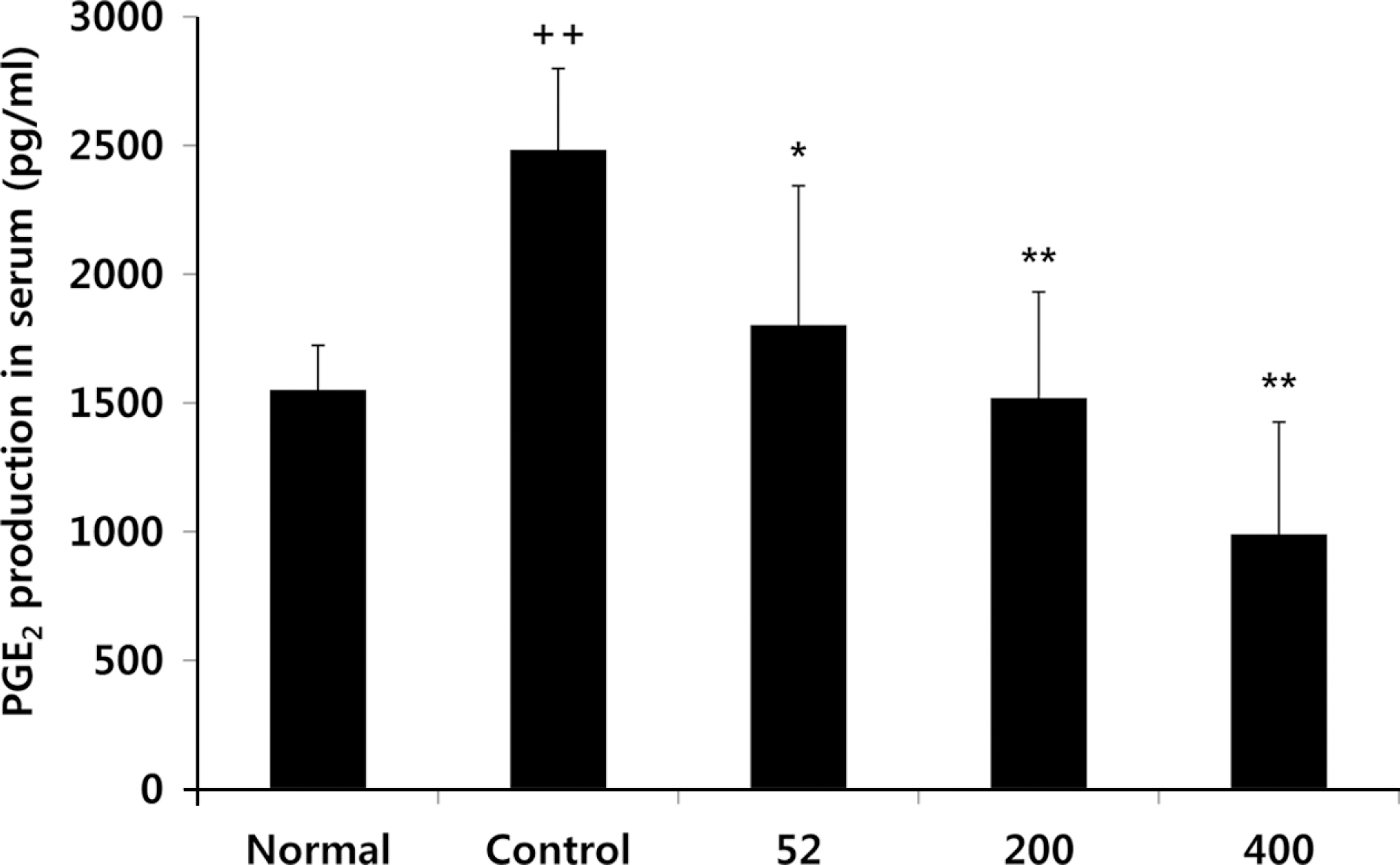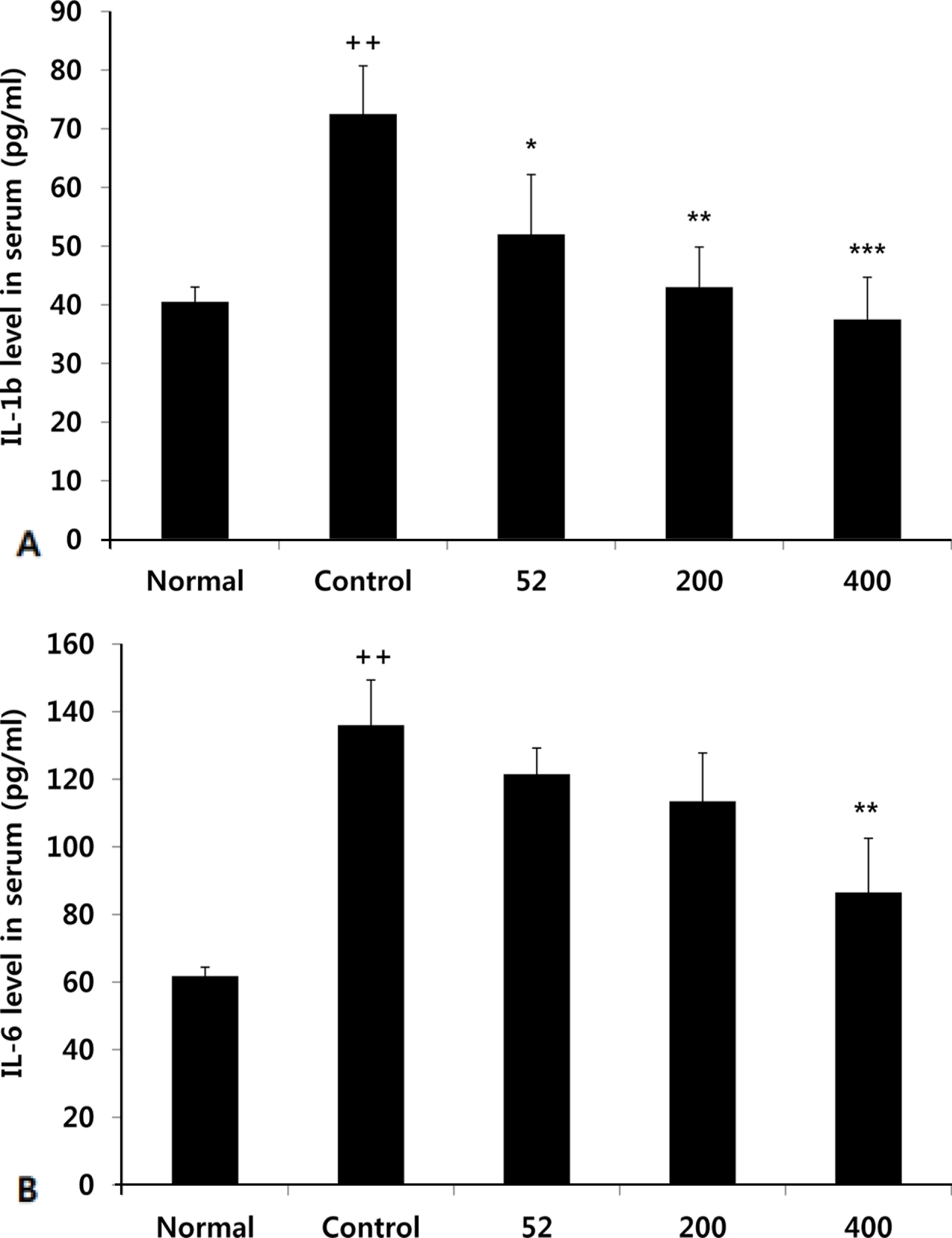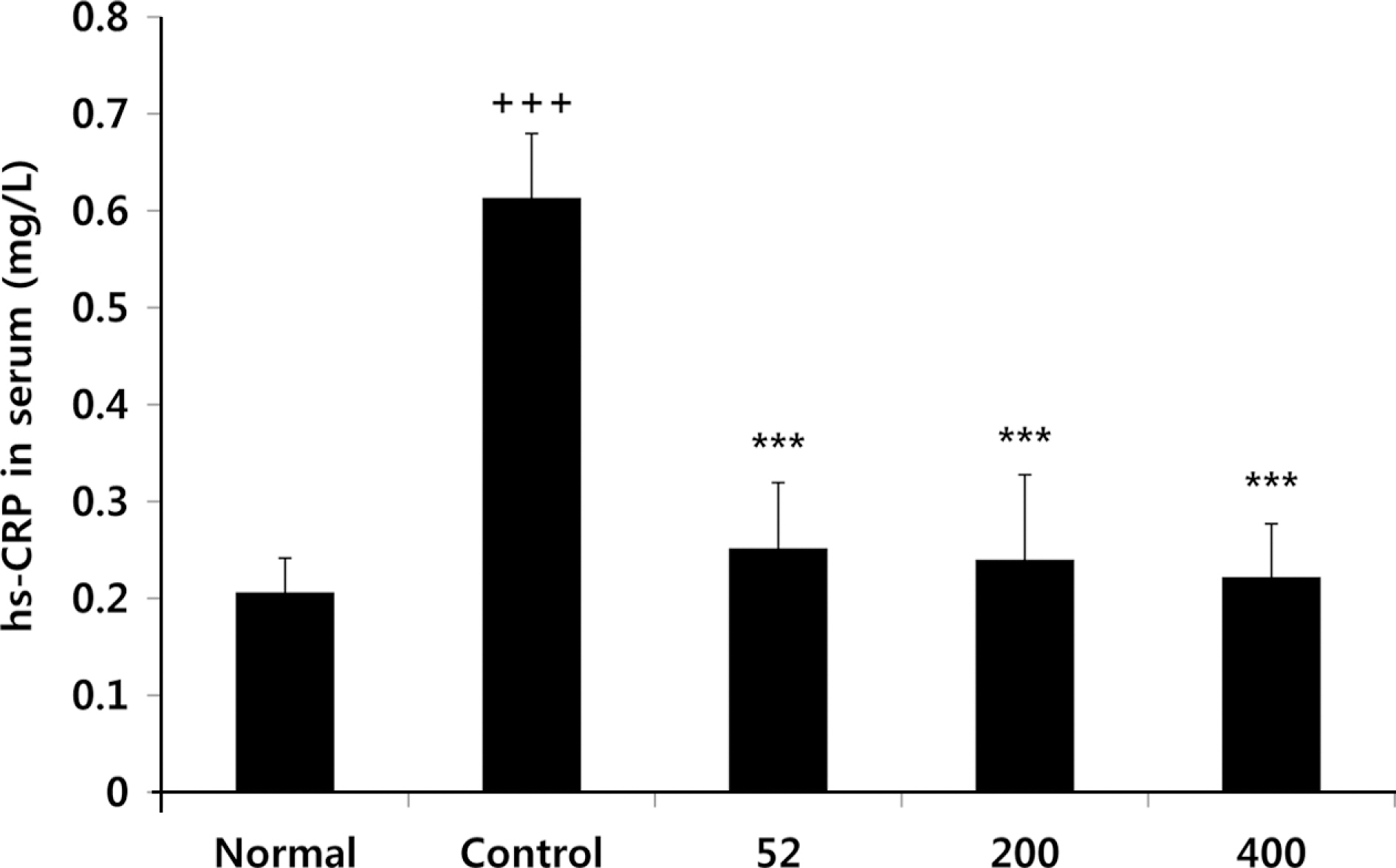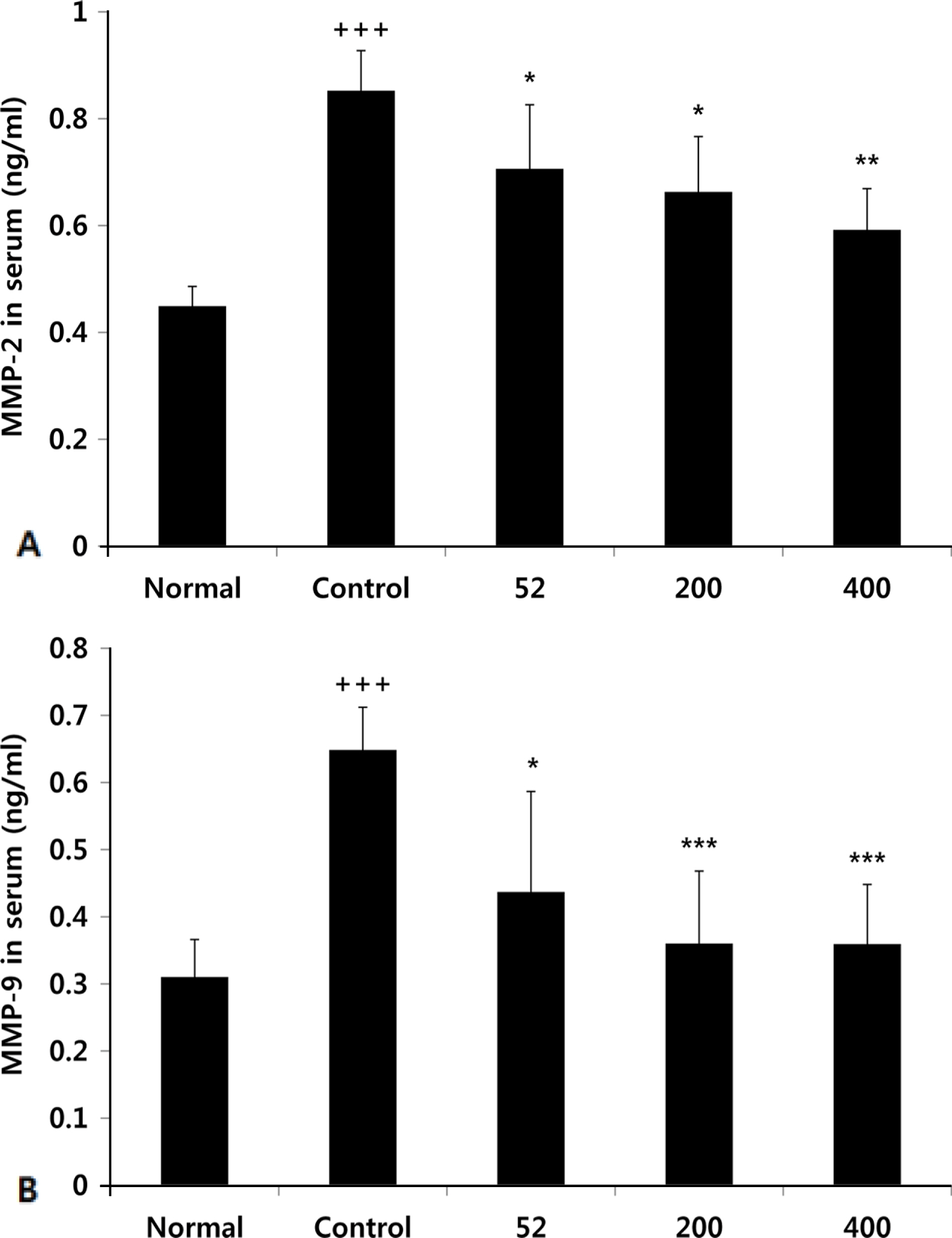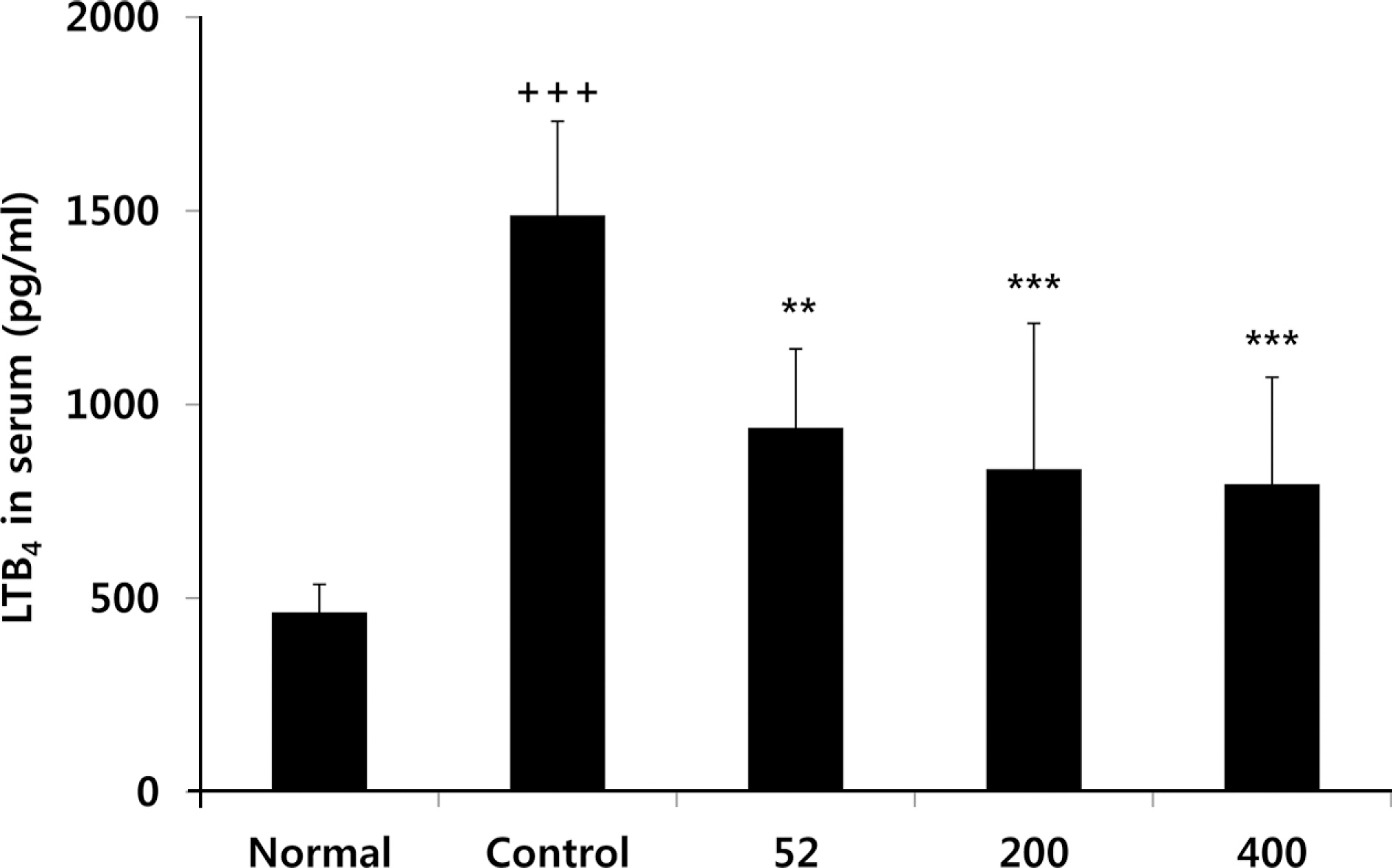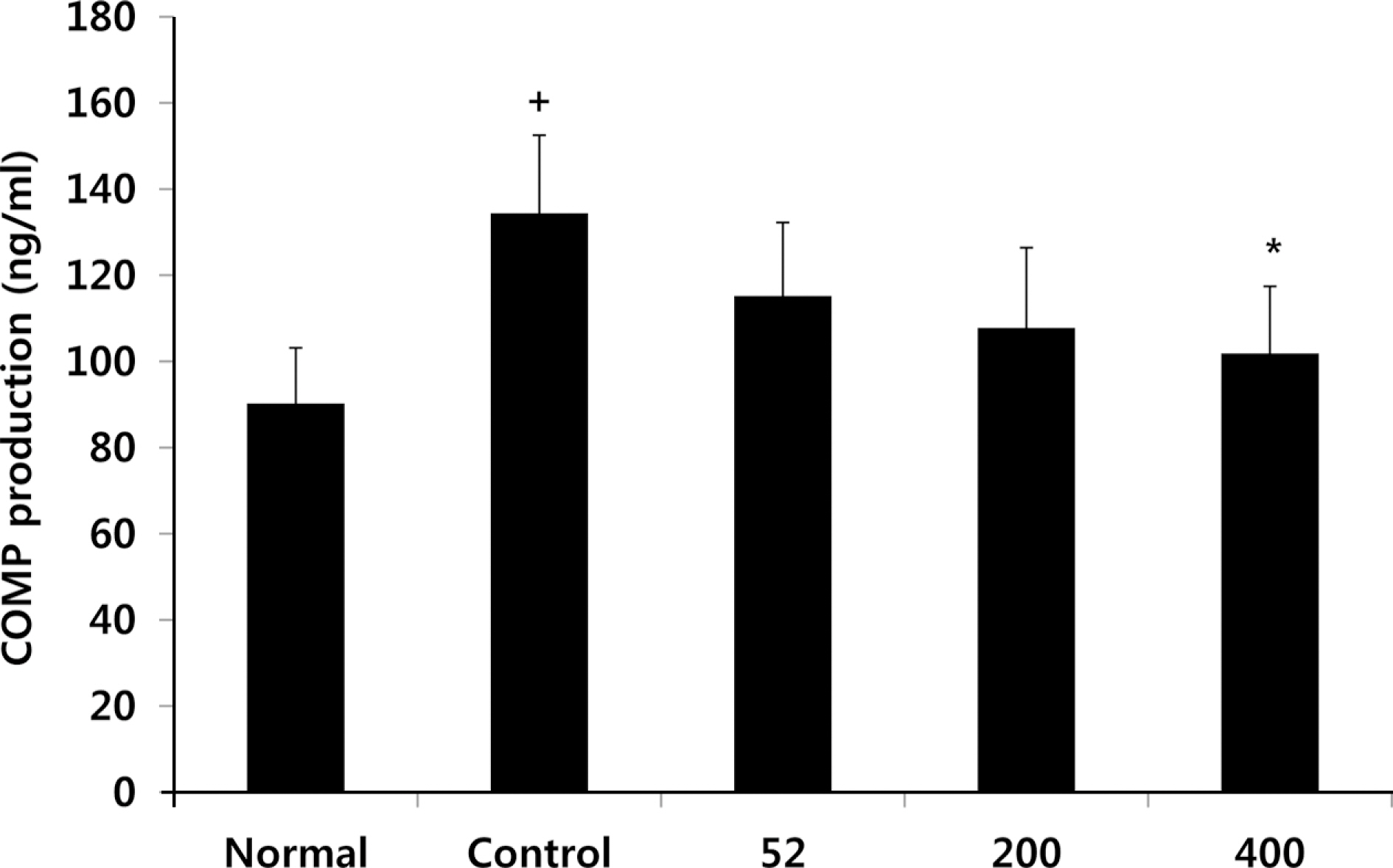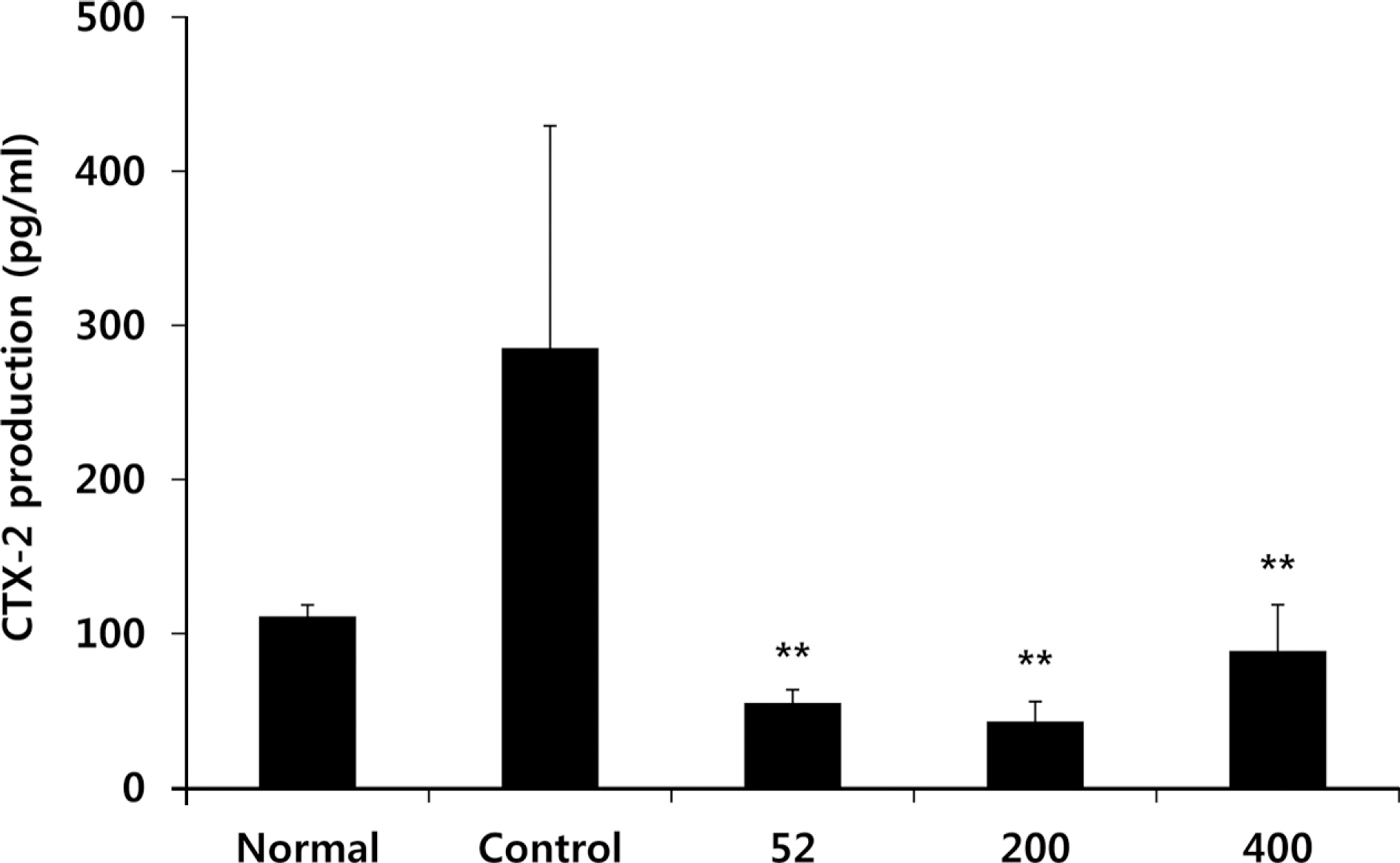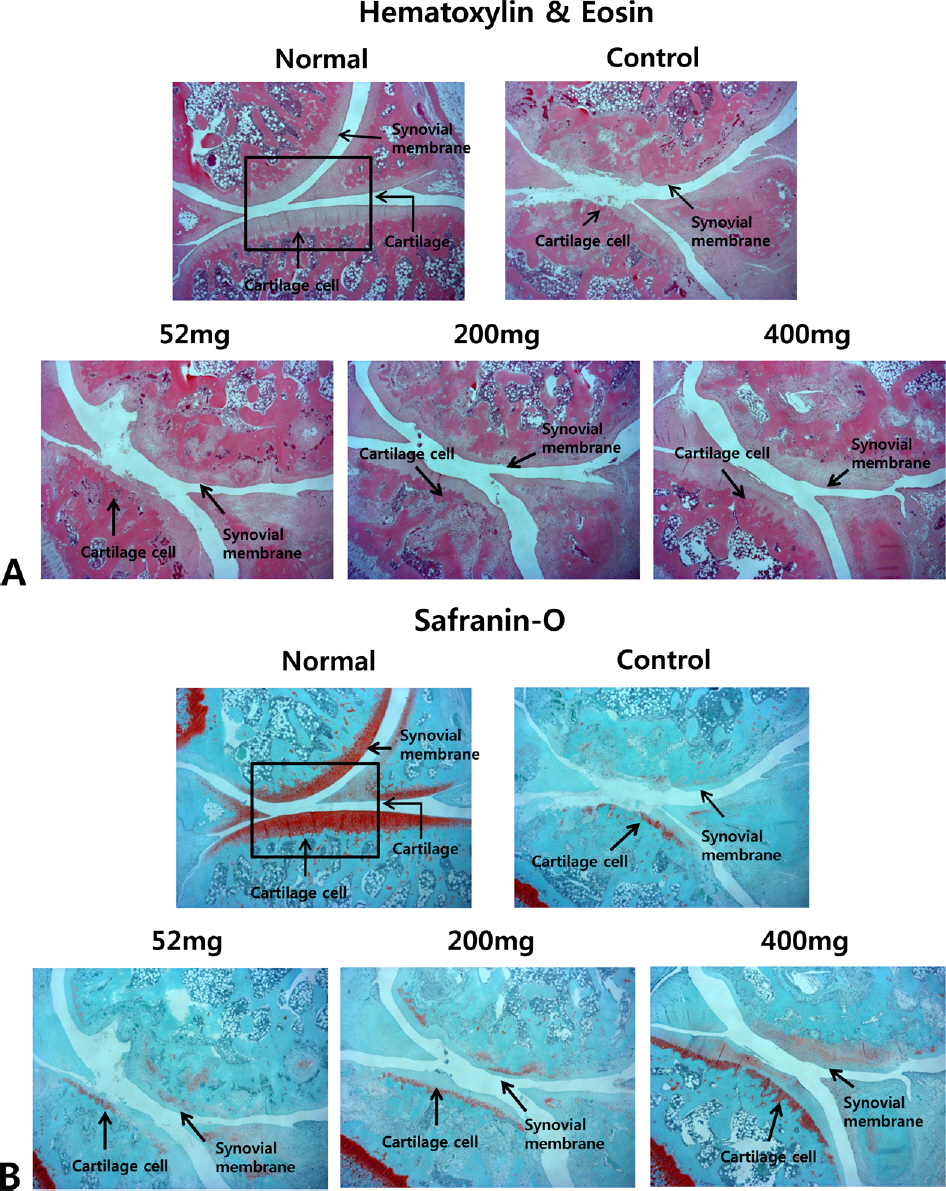J Nutr Health.
2015 Aug;48(4):310-318. 10.4163/jnh.2015.48.4.310.
Effects of natural eggshell membrane (NEM) on monosodium iodoacetate-induced arthritis in rats
- Affiliations
-
- 1Traditional and Biomedical Research Center (TBRC-RIC), Daejeon University, Daejeon 300-176, Korea. dhkim@dju.kr
- 2Ju Yeong NS Co., Ltd., Seoul 137-872, Korea.
- 3Scientific & Regulatory Affairs, ESM Technologies, LLC, 2213 Missouri St. 64836, USA.
- 4Human Nutrition, Stratum Nutrition, 43204, Tarragona, Spain.
- KMID: 2209897
- DOI: http://doi.org/10.4163/jnh.2015.48.4.310
Abstract
- PURPOSE
The aim of this study is to investigate anti-arthritis activity using natural eggshell membrane (NEM).
METHODS
NEM was administered at 52 mg/kg, 200 mg/kg, and 400 mg/kg to SD-Rat, where arthritis was induced by monosodium iodoacetate (MIA) at 3 mg. NO production in serum was measured using Griess reagent. Cytokines including IL-1beta, and IL-6 were measured by Luminex and PGE2, MMP-2, MMP-9, TIMP-1, LTB4, and hs-CRP were measured by ELISA. The cartilage of patella volume was examined and 3-D high-resolution reconstructions of the cartilage of patella were obtained using a Micro-CT system.
RESULTS
Production of NO, IL-1beta, IL-6, PGE2, MMP-2, MMP-9, TIMP-1, LTB4, and hs-CRP in serum was decreased, respectively, in comparison with control. The cartilage of patella volume increased significantly. In addition, the NEM group showed a decrease in the cartilage of patella, synovial membrane, and transformation of fibrous tissue.
CONCLUSION
The results for NEM showed significant anti-arthritis activity. These results may be developed as a raw material for new health food to ease the symptoms mentioned above.
Keyword
MeSH Terms
Figure
Reference
-
1.Korean College of Rheumatology. KCR textbook of rheumatology. Seoul: Koonja;2014.2.The Society of Korean Medicine Rehabilitation. Oriental rehabilitation medicine, 2nd revision. Seoul: Koonja;2005.3.Yoo MC. The latest trend in treating arthritis. J Rheumatol Health. 1995. 2(2):227–229.4.Auw Yang KG., Saris DB., Dhert WJ., Verbout AJ. Osteoarthritis of the knee: current treatment options and future directions. Curr Orthop. 2004. 18(4):311–320.5.Yang CH. Gastrointestinal disorders associated with non-steroidal anti-inflammatory drugs (NSAIDs). Dongguk J Med. 2003. 10(2):190–199.6.Han JD., Shin JH., Hwang HC., Kim DY., Cho WH., Im GI. Interaction of cytokines in osteolysis. J Korean Orthop Res Soc. 2000. 3(2):125–132.7.Lee JW., Do JH. Market trend of health functional food and the prospect of ginseng market. J Ginseng Res. 2005. 29(4):206–214.8.Kim HK. Current status and prospect of nutraceuticals. Food Ind Nutr. 2004. 9(1):1–14.9.Leach RM Jr., Rucker RB., Van Dyke GP. Egg shell membrane protein: a nonelastin desmosine/isodesmosine-containing protein. Arch Biochem Biophys. 1981. 207(2):353–359.10.Okubo T., Akachi S., Hatta H. Structure of hen eggs and physiology of egg laying. Yamamoto T, Juneja LR, Hatta H, Kim M, editors. editors.Hen Eggs: Their Basic and Applied Science. Boca Raton (FL): CRC Press;1997. p. 1–12.
Article11.Jeon TW., Park KM. Functional properties of egg shell membrane hydrolysate as a food material. J Korean Soc Food Sci Anim Resour. 2002. 22(3):267–273.12.Ruff KJ., DeVore DP. Reduction of pro-inflammatory cytokines in rats following 7-day oral supplementation with a proprietary eggshell membrane-derived product. Mod Res Inflamm. 2014. 3(1):19–25.
Article13.Ruff KJ., Winkler A., Jackson RW., DeVore DP., Ritz BW. Eggshell membrane in the treatment of pain and stiffness from osteoarthritis of the knee: a randomized, multicenter, double-blind, placebo-controlled clinical study. Clin Rheumatol. 2009. 28(8):907–914.
Article14.Jung YO. Pathogenesis of osteoarthritis. Diagn Treat. 2007. 27(4):395–399.15.Kim CS., Park YK. The therapeutic effect of Achyranthis Radix on the collagen-induced arthritis in mice. Korean J Herbol. 2010. 25(4):129–135.16.Wu W., Xu X., Dai Y., Xia L. Therapeutic effect of the saponin fraction from Clematis chinensis Osbeck roots on osteoarthritis induced by monosodium iodoacetate through protecting articular cartilage. Phytother Res. 2010. 24(4):538–546.
Article17.Wesche-Soldato DE., Swan RZ., Chung CS., Ayala A. The apoptotic pathway as a therapeutic target in sepsis. Curr Drug Targets. 2007. 8(4):493–500.
Article18.Herrington C., Hall PA. Molecular and cellular themes in inflammation and immunology. J Pathol. 2008. 214(2):123–125.
Article19.Campo GM., Avenoso A., Campo S., D'Ascola A., Traina P., Samà D., Calatroni A. Glycosaminoglycans modulate inflammation and apoptosis in LPS-treated chondrocytes. J Cell Biochem. 2009. 106(1):83–92.
Article20.Clancy RM., Amin AR., Abramson SB. The role of nitric oxide in inflammation and immunity. Arthritis Rheum. 1998. 41(7):1141–1151.
Article21.Rice-Evance C., Miller N., Paganga G. Antioxidant properties of phenolic compounds. Trends Plant Sci. 1997. 2(4):152–159.22.Chang ST., Wu JH., Wang SY., Kang PL., Yang NS., Shyur LF. Antioxidant activity of extracts from Acacia confusa bark and heartwood. J Agric Food Chem. 2001. 49(7):3420–3424.
Article23.Hardy MM., Seibert K., Manning PT., Currie MG., Woerner BM., Edwards D., Koki A., Tripp CS. Cyclooxygenase 2-dependent prostaglandin E2 modulates cartilage proteoglycan degradation in human osteoarthritis explants. Arthritis Rheum. 2002. 46(7):1789–1803.
Article24.Okamoto H., Hoshi D., Kiire A., Yamanaka H., Kamatani N. Molecular targets of rheumatoid arthritis. Inflamm Allergy Drug Targets. 2008. 7(1):53–66.
Article25.Scheinecker C., Redlich K., Smolen JS. Cytokines as therapeutic targets: advances and limitations. Immunity. 2008. 28(4):440–444.
Article26.Ji JD. Cytokines in rheumatoid arthritis. Hanyang Med Rev. 2005. 25(2):43–52.27.Hulejová H., Baresová V., Klézl Z., Polanská M., Adam M., Senolt L. Increased level of cytokines and matrix metalloproteinases in osteoarthritic subchondral bone. Cytokine. 2007. 38(3):151–156.
Article28.LeGrand A., Fermor B., Fink C., Pisetsky DS., Weinberg JB., Vail TP., Guilak F. Interleukin-1, tumor necrosis factor alpha, and interleukin-17 synergistically up-regulate nitric oxide and prostaglandin E2 production in explants of human osteoarthritic knee menisci. Arthritis Rheum. 2001. 44(9):2078–2083.29.Tak MJ., Tak MR., Kang KH., Ko WS., Yoon HJ. The Inhibitory effects of Yang Geouk San Hwa-Tang on LPS-stimulated inflammation in RAW264.7 macrophage cells. J Korean Orient Med Ophthalmol Otolaryngol Dermatol. 2010. 23(1):118–134.30.Madson KL., Moore TL., Lawrence JM 3rd., Osborn TG. Cytokine levels in serum and synovial fluid of patients with juvenile rheumatoid arthritis. J Rheumatol. 1994. 21(12):2359–2363.31.Yeo HJ., Lee JH., Lee HJ., Byun KS., Im HJ., Kim MJ. Microvascular findings in patients with rheumatoid arthritis: assessed, using fundus photography and fluorescein angiography. J Rheum Dis. 2013. 20(4):231–237.32.Madhok R., Crilly A., Watson J., Capell HA. Serum interleukin 6 levels in rheumatoid arthritis: correlations with clinical and laboratory indices of disease activity. Ann Rheum Dis. 1993. 52(3):232–234.
Article33.Reijman M., Hazes JM., Bierma-Zeinstra SM., Koes BW., Christgau S., Christiansen C., Uitterlinden AG., Pols HA. A new marker for osteoarthritis: cross-sectional and longitudinal approach. Arthritis Rheum. 2004. 50(8):2471–2478.
Article34.Garnero P., Peterfy C., Zaim S., Schoenharting M. Bone marrow abnormalities on magnetic resonance imaging are associated with type II collagen degradation in knee osteoarthritis: a three-month longitudinal study. Arthritis Rheum. 2005. 52(9):2822–2829.
Article35.Elsaid KA., Chichester CO. Review: collagen markers in early arthritic diseases. Clin Chim Acta. 2006. 365(1-2):68–77.
Article36.Bresnihan B. Pathogenesis of joint damage in rheumatoid arthritis. J Rheumatol. 1999. 26(3):717–719.37.Peters-Golden M., Henderson WR Jr. Leukotrienes. N Engl J Med. 2007. 357(18):1841–1854.
Article
- Full Text Links
- Actions
-
Cited
- CITED
-
- Close
- Share
- Similar articles
-
- Erratum: Abstract & Figure Correction. Effects of natural eggshell membrane (NEM) on monosodium iodoacetate-induced arthritisin rats
- Anti-inflammatory effect of egg white-chalcanthite and purple bamboo salts mixture on arthritis induced by monosodium iodoacetate in Sprague-Dawley rats
- Micro-CT Arthrographic Analysis of Monosodium Iodoacetate-Induced Osteoarthritis in Rat Knees
- Anti-osteoarthritis effect of Boswellia serrata gum resin extract in monosodium iodoacetate-induced osteoarthritic Sprague-Dawley rats
- Effects of salmon DNA fraction in vitro and in a monosodium iodoacetate-induced osteoarthritis rat model

